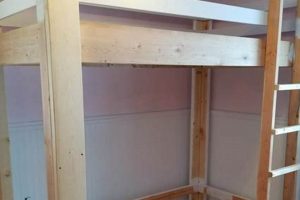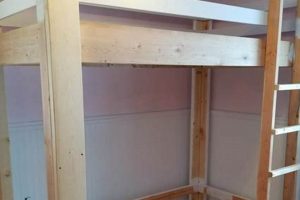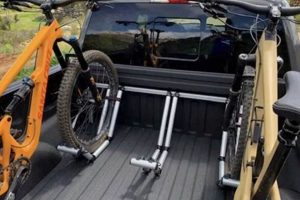A do-it-yourself project focused on constructing a raised, flat surface within the cargo area of a pickup truck intended for use as a sleeping area. This construction often involves the utilization of wood, metal, or composite materials to create a level platform capable of supporting the weight of one or more individuals. As an example, an individual might design and build a wooden frame with plywood sheeting to fit securely within their truck bed, thereby creating a comfortable and protected sleeping space.
The creation of a sleeping surface within a truck bed offers numerous advantages, including cost-effective accommodation during outdoor recreation, travel, or emergency situations. Its development reflects a desire for readily available and adaptable sleeping arrangements, circumventing the need for traditional tents or costly lodging. Historically, individuals have modified vehicles for mobile living; this project represents a continuation of that trend, adapted to modern truck designs and materials.
The following sections will delve into crucial aspects of planning and executing a successful project, covering design considerations, material selection, construction techniques, safety precautions, and customization options to ensure a practical and comfortable outcome.
Essential Considerations for Truck Bed Sleeping Platform Construction
The successful implementation of a sleeping platform within a truck bed necessitates careful planning and execution. Adherence to the following guidelines will contribute to a safe, functional, and durable structure.
Tip 1: Accurate Measurement is Paramount: Before commencing any construction, precise measurements of the truck bed’s interior dimensions are critical. Account for wheel wells, bed liner contours, and any other obstructions that may affect platform fitment. Document all measurements meticulously to avoid errors during the building phase.
Tip 2: Prioritize Structural Integrity: The platform must be capable of supporting the anticipated weight load. Select materials with adequate strength and rigidity. Reinforce joints and stress points with appropriate hardware, such as screws, bolts, and metal brackets. Consult load-bearing charts for specific material specifications.
Tip 3: Ventilation is Crucial: Enclosed truck beds can accumulate condensation and heat. Incorporate ventilation strategies, such as strategically placed vents or breathable fabric coverings, to mitigate moisture buildup and ensure comfortable sleeping conditions.
Tip 4: Secure Platform Attachment: The platform must be securely anchored to the truck bed to prevent shifting during transit. Utilize existing tie-down points or install dedicated anchor points. Employ robust fastening mechanisms, such as ratchet straps or bolted connections, to maintain stability.
Tip 5: Optimize Storage Solutions: Maximize the use of space beneath the platform for storage. Design access panels or drawers to facilitate easy retrieval of gear and supplies. Consider the dimensions of commonly stored items when planning the storage layout.
Tip 6: Material Selection Based on Environment: Choose materials that are resistant to moisture, temperature fluctuations, and UV exposure. Pressure-treated lumber or marine-grade plywood are suitable options for humid environments. Protect wooden components with weatherproof coatings to extend their lifespan.
Tip 7: Emphasize Safety Considerations: Eliminate sharp edges or protruding hardware that could pose a safety hazard. Install padding or edge trim to protect occupants from injury. Ensure that the platform design allows for easy egress in emergency situations.
By adhering to these guidelines, the construction of a robust and functional sleeping platform can be achieved, enhancing the utility and versatility of the truck bed.
The subsequent section will explore specific design options and customization techniques to tailor the platform to individual needs and preferences.
1. Measurements
Accurate measurements are fundamental to the successful execution of a truck bed sleeping platform construction. Dimensional discrepancies between the platform and the truck bed can lead to instability, reduced functionality, and potential safety hazards. Inaccurate measurements manifest as a platform that either does not fit within the truck bed, leaving unusable gaps, or requires forceful installation, potentially damaging the truck bed or the platform structure itself. For example, if the wheel well dimensions are not precisely accounted for, the platform may not sit flush against the bed, resulting in a reduced sleeping area and compromised structural integrity.
The specific dimensions to be measured extend beyond the length and width of the truck bed. The height from the bed floor to the top of the wheel wells, the distance between tie-down points, and the presence of any bed liners or other accessories that may impinge upon the available space must be documented. These measurements serve as the foundation for designing a platform that maximizes usable space while minimizing potential interference. A real-world application involves creating a CAD model or detailed blueprint based on these measurements prior to any material cutting, enabling preemptive identification and rectification of potential fitment issues. This iterative process ensures dimensional accuracy prior to the physical construction phase.
In conclusion, the precision of measurements directly impacts the overall quality, safety, and usability of a truck bed sleeping platform. Neglecting this critical step increases the likelihood of errors and compromises the structural soundness and intended functionality of the completed project. Emphasizing accuracy from the outset minimizes material waste, reduces construction time, and ensures a reliable and comfortable sleeping arrangement within the confines of the truck bed.
2. Materials
Material selection directly influences the structural integrity, durability, and overall comfort of a truck bed sleeping platform. The choice of materials dictates the platform’s ability to withstand weight, resist environmental factors such as moisture and temperature fluctuations, and provide a stable sleeping surface. The use of substandard materials, such as low-grade plywood lacking sufficient thickness, can result in a platform that sags or collapses under load. Conversely, the selection of appropriate materials, such as high-density plywood or reinforced metal framing, ensures a robust and long-lasting structure. For instance, marine-grade plywood treated with a waterproof sealant is a suitable choice for environments with high humidity or frequent exposure to rain, mitigating the risk of rot and structural degradation. Similarly, using lightweight aluminum framing can reduce the overall weight of the platform, improving fuel efficiency during transport and simplifying installation and removal.
The interplay between material choice and design considerations is also critical. The structural design of the platform must complement the chosen materials to maximize strength and stability. For example, a platform constructed from relatively thin plywood may require additional support beams or cross-bracing to prevent flexing under load. Similarly, if a platform is designed to be easily disassembled for storage, the choice of connectors and fasteners becomes paramount. Robust hinges, latches, and bolts ensure that the platform can be repeatedly assembled and disassembled without compromising structural integrity. In a practical application, a platform designed for frequent use may benefit from the incorporation of a durable, non-slip surface material, such as carpet or rubber matting, to enhance safety and comfort.
Ultimately, the selection of appropriate materials is a cornerstone of the process. Careful consideration of weight requirements, environmental conditions, and design constraints ensures a safe, comfortable, and durable sleeping surface. Prioritizing material quality and compatibility, in conjunction with sound construction techniques, contributes to a long-lasting and functional addition to a truck bed. Neglecting this element results in a structure susceptible to premature failure, increased maintenance, and compromised user safety.
3. Structural Support
Adequate structural support is a critical determinant of the safety and longevity of any truck bed sleeping platform. The platform must withstand static and dynamic loads exerted during use, ensuring a stable and secure sleeping environment. Insufficient structural support can lead to catastrophic failure, resulting in injury or damage to the vehicle.
- Load-Bearing Capacity
The platform’s frame and surface must be engineered to bear the anticipated weight of occupants and their belongings. This involves selecting materials with appropriate strength ratings and designing a frame that distributes the load evenly. As an example, a platform designed for two adults requires a substantially higher load-bearing capacity than one intended for a single occupant. Exceeding the load-bearing capacity can cause structural deformation or collapse, posing a significant safety risk.
- Frame Construction and Material Selection
The frame serves as the primary structural element, providing rigidity and stability. Common materials include wood, steel, and aluminum. Wood frames offer ease of construction and cost-effectiveness, but require careful selection of lumber species and joinery techniques to ensure adequate strength. Steel frames provide superior strength and durability but are heavier and require welding expertise. Aluminum frames offer a balance of strength and weight but are more expensive and require specialized welding techniques. The chosen material must be compatible with the intended use and environmental conditions.
- Joint Reinforcement and Fasteners
The points where frame members connect are critical stress points. Reinforcement techniques, such as gussets, brackets, and strategically placed fasteners, are essential to prevent joint failure. The selection of fasteners, including screws, bolts, and rivets, must be appropriate for the chosen materials and the anticipated loads. Insufficiently sized or improperly installed fasteners can lead to joint weakening and eventual structural collapse. For example, using drywall screws in a load-bearing application is inappropriate due to their low shear strength.
- Platform Surface Stability
The surface material, typically plywood or composite sheeting, must be adequately supported by the frame to prevent sagging or flexing. The spacing of support members beneath the surface is a key determinant of surface stability. Wider spacing requires thicker surface material to prevent deflection. Reinforcing ribs or stringers can also be incorporated to enhance surface stiffness. Insufficient surface support can result in an uncomfortable sleeping surface and increase the risk of material failure.
The design and implementation of adequate structural support are paramount considerations. A well-engineered platform provides a safe and comfortable sleeping environment, while a poorly designed platform can pose significant safety risks and compromise the utility. Thus, it can be said with no doubt the importance of structural support for truck bed sleeping platform diy.
4. Ventilation
The integration of effective ventilation is a crucial, yet often overlooked, aspect of successful truck bed sleeping platform construction. Its absence can precipitate a cascade of negative effects, ranging from diminished comfort to compromised health and structural integrity. Specifically, the confined space within a truck bed, when enclosed by a sleeping platform and potentially a topper or canopy, creates an environment prone to moisture accumulation and temperature extremes. This is especially pronounced during periods of inclement weather or in regions with high humidity. The condensation of exhaled moisture, coupled with ambient humidity, saturates bedding and the platform structure itself, fostering mold and mildew growth. Inhalation of mold spores can trigger allergic reactions, respiratory problems, and other adverse health effects for occupants. Furthermore, prolonged exposure to moisture accelerates the deterioration of wooden platform components, leading to structural weakening and premature failure.
Design considerations for ventilation strategies vary depending on the climate, anticipated usage patterns, and desired level of security. Passive ventilation systems, such as strategically placed screened vents or permeable fabric panels, allow for natural airflow without requiring mechanical components. Active ventilation systems, which incorporate fans or powered vents, offer greater control over airflow and can be particularly beneficial in hot or humid conditions. The placement of ventilation openings is crucial; vents positioned high within the enclosure facilitate the escape of warm, moist air, while vents placed low promote the intake of cooler, drier air. In a practical implementation, a truck bed sleeping platform designed for use in coastal environments would necessitate a more robust ventilation system, potentially incorporating moisture-wicking materials and an active dehumidifier, to combat the pervasive effects of saltwater intrusion and high humidity.
Effective ventilation is not merely a comfort enhancement; it constitutes a fundamental component of a well-designed truck bed sleeping platform. By mitigating moisture accumulation, regulating temperature, and promoting healthy air circulation, a properly ventilated platform ensures occupant well-being and prolongs the lifespan of the structure. Failure to address ventilation needs results in a suboptimal sleeping environment and increased risk of health and structural problems, ultimately undermining the value and utility of the project. Prioritizing thoughtful ventilation design yields a more comfortable, durable, and ultimately safer sleeping space within the confines of the truck bed.
5. Securing
Securing constitutes a critical safety and functionality element within the context of a do-it-yourself truck bed sleeping platform project. The platform, by its nature, is a modification to the vehicle’s original design, introducing a significant mass within the cargo area. Inadequate securing measures can lead to displacement of the platform during vehicle operation, particularly during sudden stops, turns, or off-road driving conditions. This displacement not only poses a direct hazard to occupants within the truck bed but also can destabilize the vehicle, increasing the risk of accidents. For instance, a loosely secured platform shifting during emergency braking can alter the vehicle’s center of gravity, potentially leading to loss of control. The cause-and-effect relationship is clear: insufficient securing leads directly to increased risk of injury and vehicle damage.
Effective securing strategies involve utilizing robust attachment points and methods to anchor the platform to the truck bed. Existing tie-down points, if suitably located and rated, can be employed, supplemented by additional anchor points installed directly into the truck bed frame. These anchor points must be capable of withstanding significant tensile and shear forces. Fastening mechanisms, such as heavy-duty ratchet straps, bolted connections with reinforced plates, or custom-fabricated brackets, ensure the platform remains firmly fixed to the vehicle. Practical application requires careful consideration of the platform’s weight, dimensions, and the expected driving conditions to determine the appropriate number and placement of securing points. Ignoring this step can result in catastrophic failure, as evidenced by instances where improperly secured cargo has shifted and caused vehicle rollovers.
In conclusion, securing is not merely an ancillary consideration but an integral component of a safe and functional truck bed sleeping platform. The challenges lie in correctly assessing the forces acting upon the platform during vehicle operation and implementing securing measures that exceed those forces. Overlooking this crucial aspect compromises both the safety of occupants and the integrity of the vehicle itself. Therefore, meticulous attention to securing protocols is paramount for any individual undertaking a truck bed sleeping platform project.
6. Storage access
Within the context of a truck bed sleeping platform, storage access is not merely a convenience but a functional necessity inextricably linked to the project’s overall utility. The construction of a sleeping platform inherently reduces the available space within the truck bed, necessitating strategic planning for the storage of gear, supplies, and personal belongings. Neglecting storage access considerations renders the platform a hindrance, transforming valuable cargo space into an inaccessible void. For example, a platform lacking accessible storage compartments forces occupants to unpack and rearrange items atop the sleeping surface to retrieve needed equipment, disrupting the sleeping area and compromising efficiency. Therefore, storage access is an integral design consideration directly impacting the practicality and usability of the sleeping platform.
Effective storage access solutions are multifaceted, encompassing various design approaches tailored to specific needs and preferences. Options range from simple hinged access panels providing entry to the space beneath the platform to more sophisticated drawer systems or slide-out compartments that maximize organization and accessibility. The choice of storage access method must consider the size and shape of items to be stored, the frequency of access required, and the available space beneath the platform. A practical application involves integrating lockable drawers for secure storage of valuables or tools, while utilizing open compartments for frequently accessed items like clothing or camping gear. The design should also account for the weight distribution of stored items to maintain platform stability and prevent uneven loading on the truck bed.
In summary, the integration of well-planned storage access is essential for maximizing the functional value of a truck bed sleeping platform. Failure to prioritize storage access transforms a potentially versatile asset into an inefficient and cumbersome obstruction. Addressing storage needs through thoughtful design and implementation ensures that the platform enhances, rather than detracts from, the overall utility of the truck bed. Therefore, storage access is not an optional add-on but an indispensable element of a successful truck bed sleeping platform project, directly influencing its practicality and user satisfaction.
7. Safety
The implementation of safety protocols is paramount in the execution of any do-it-yourself truck bed sleeping platform project. The inherent risks associated with structural modifications to vehicles and the potential for injury during construction and use necessitate a comprehensive approach to safety management.
- Structural Integrity and Load Capacity
The platform’s structural integrity is directly related to occupant safety. Inadequate load-bearing capacity can lead to collapse, resulting in injury. Verification of material strength, proper joinery techniques, and load testing are essential to mitigate this risk. For instance, a platform designed for a single occupant failing under the weight of two could result in serious harm.
- Secure Platform Attachment
A properly secured platform prevents movement during vehicle operation. Shifting or dislodged platforms can cause vehicle instability or block egress in emergency situations. Utilizing robust fastening mechanisms and multiple anchor points is critical. An example of inadequate attachment is a platform held in place only by friction, which is likely to shift during sudden braking.
- Hazard Mitigation: Edges and Protrusions
The presence of sharp edges, protruding hardware, or unsecured components poses a significant risk of cuts, abrasions, and impalement. Thoroughly inspect the platform for potential hazards and implement protective measures such as edge trim, padding, and recessed fasteners. An untrimmed screw protruding from the platform surface is a clear safety violation.
- Ventilation and Air Quality
Enclosed truck bed environments can accumulate condensation and reduce air quality. Insufficient ventilation can lead to mold growth and respiratory distress. Incorporating ventilation strategies and selecting breathable materials are essential to maintain a safe and healthy sleeping environment. A sealed platform, lacking ventilation, creates a breeding ground for mold and mildew.
These facets collectively underscore the critical role of safety considerations in any truck bed sleeping platform undertaking. Ignoring any of these elements compromises the well-being of occupants and undermines the intended functionality of the project. Thorough planning, meticulous execution, and adherence to established safety protocols are indispensable for a successful and safe outcome.
Frequently Asked Questions
The following questions address common inquiries and concerns regarding the design, construction, and utilization of truck bed sleeping platforms.
Question 1: What are the primary considerations in determining the appropriate load capacity for a truck bed sleeping platform?
The calculation of load capacity necessitates accounting for the combined weight of all potential occupants, including adults, children, and pets, in addition to any gear or equipment stored on the platform. A safety factor should be incorporated to accommodate dynamic loads experienced during vehicle movement.
Question 2: What are the advantages and disadvantages of using wood versus metal for the platform frame?
Wood offers ease of construction, cost-effectiveness, and sound dampening properties. However, it is susceptible to moisture damage and may require more frequent maintenance. Metal provides superior strength and durability but is heavier, more expensive, and requires specialized welding skills.
Question 3: How can adequate ventilation be achieved within a confined truck bed sleeping platform environment?
Ventilation can be achieved through the incorporation of strategically placed screened vents, breathable fabric panels, or active ventilation systems utilizing fans. The placement of vents should facilitate cross-ventilation and promote the expulsion of warm, moist air.
Question 4: What are the recommended methods for securely attaching a sleeping platform to the truck bed?
Secure attachment can be achieved through the utilization of existing tie-down points, supplemented by additional anchor points installed into the truck bed frame. Robust fastening mechanisms, such as ratchet straps or bolted connections with reinforced plates, are essential.
Question 5: How can storage space be maximized within a truck bed sleeping platform design?
Storage space can be maximized through the integration of hinged access panels, drawer systems, or slide-out compartments beneath the platform. The design should consider the size and shape of items to be stored and the frequency of access required.
Question 6: What safety precautions should be observed during the construction and use of a truck bed sleeping platform?
Safety precautions include verifying structural integrity, ensuring secure platform attachment, mitigating hazards from sharp edges and protrusions, and maintaining adequate ventilation. Regular inspection of the platform for signs of wear or damage is also recommended.
Adhering to established safety protocols and employing sound construction techniques are indispensable for a safe and functional project.
The subsequent section will explore design templates and step-by-step instructions for realizing this concept.
Truck Bed Sleeping Platform DIY
The preceding analysis has examined various critical facets of engaging in a truck bed sleeping platform project. From meticulous measurement protocols and judicious material selection to the imperative of robust structural support, effective ventilation strategies, secure platform anchoring, and accessible storage solutions, each element plays a pivotal role in determining the ultimate functionality, safety, and longevity of the finished product. Moreover, a comprehensive understanding of these aspects empowers the prospective builder to make informed decisions, mitigating potential risks and maximizing the inherent benefits of a customized sleeping solution within the confines of a pickup truck bed.
The construction of a truck bed sleeping platform represents a significant undertaking, demanding careful planning, precise execution, and a unwavering commitment to safety. A successful project transcends mere construction; it embodies a fusion of practicality, ingenuity, and a deep appreciation for the potential offered by mobile living. Therefore, diligent application of the principles outlined herein is not merely advisable but essential for achieving a durable, functional, and safe sleeping environment that will provide years of reliable service.







